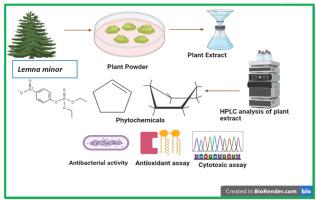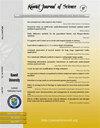GC-MS、FTIR、XRD、UV-Vis和HPLC分析了柠檬草提取物的天然活性成分及其对病原菌的体外抗菌和抗寄生活性
IF 1.1
4区 综合性期刊
Q3 MULTIDISCIPLINARY SCIENCES
引用次数: 0
摘要
目前的研究重点是通过近似分析、紫外光谱(UV)、气相色谱和质谱(GC-MS)、傅里叶变换红外光谱(FTIR)和x射线衍射分析(XRD)等方法对普通浮萍进行定性和定量的植物化学分析。对不同干燥方法提取的粉末样品和新鲜样品的植物化学性质进行了比较。新鲜样品的水分含量最高(87.94%),干粉的灰分、纤维和蛋白质含量最高(14.81%、24.01%和34.92%)。冻干粉的脂肪含量最高(8.48%),碳水化合物含量最高(17.5%)。定性植物化学分析检测到不同浓度的生物活性化合物。定量分析表明,在所有溶剂中单宁含量最高,而非极性或极性类固醇的提取量最少。在矿物质含量方面,冻干植物样品中钾含量最高(54.51 mg/100g),其次是磷(31.750.25 mg/100g)、镁(18.25±0.25 mg/100g)和钠(4.4±1 mg/100g)。对大肠杆菌的抑菌潜力最大,为21.4 mm的抑制区(ZOI)。同样,在最高浓度为75 μl时,对黑曲霉的抑制效果为21 mm。在150 g/mL浓度下,虫体的promastigoi和amastigoi的死亡率分别为75.40±1.16和60.15±0.12。本文章由计算机程序翻译,如有差异,请以英文原文为准。

GC-MS, FTIR, XRD, UV–Vis, and HPLC profiling of the natural bioactive constituents of Lemna minor L. extract and its in-vitro antimicrobial and anti-parasitic activities against pathogenic organisms
The current study focuses on Lemna minor L. (common duckweed) through proximate analysis, qualitative and quantitative phytochemical analysis by UV spectroscopy (UV), gas chromatography and mass spectroscopy (GC-MS), Fourier-transform infrared (FTIR) spectroscopy, and X-ray diffraction analysis (XRD). The phytochemical investigation of the fresh sample of L. minor was compared with the powdered sample extracted using different drying procedures. The highest moisture content was recorded in fresh samples (87.94 %), while maximum percentages of ash, fiber, and protein were found in oven-dried powder as 14.81 %, 24.01 %, and 34.92 %, respectively. The freeze-dried powder contained the greatest percentages of fat (8.48 %) and carbohydrates (17.5 %). The qualitative phytochemical analysis detected variable concentrations of bioactive compounds. Quantitative analysis revealed that tannins were found in the maximum concentration across all solvents, while non-polar or polar steroids were extracted the least. In terms of mineral content, the freeze-dried plant samples contained the maximum levels of potassium (54.51 mg/100g), followed by phosphorus (31.750.25 mg/100g), magnesium (18.25 ± 0.25 mg/100g) and sodium (4.4 ± 1 mg/100g). The maximum antibacterial potential was achieved against E. coli, that was 21.4 mm zone of inhibition (ZOI). Similarly, the maximum fungal inhibition was observed against A. niger, which was 21 mm ZOI at the highest concentration of 75 μl. The parasite's promastigote and amastigote forms each had a significant death rate of 75.40 ± 1.16 and 60.15 ± 0.12 at 150 g/mL, respectively.
求助全文
通过发布文献求助,成功后即可免费获取论文全文。
去求助
来源期刊

Kuwait Journal of Science
MULTIDISCIPLINARY SCIENCES-
CiteScore
1.60
自引率
28.60%
发文量
132
期刊介绍:
Kuwait Journal of Science (KJS) is indexed and abstracted by major publishing houses such as Chemical Abstract, Science Citation Index, Current contents, Mathematics Abstract, Micribiological Abstracts etc. KJS publishes peer-review articles in various fields of Science including Mathematics, Computer Science, Physics, Statistics, Biology, Chemistry and Earth & Environmental Sciences. In addition, it also aims to bring the results of scientific research carried out under a variety of intellectual traditions and organizations to the attention of specialized scholarly readership. As such, the publisher expects the submission of original manuscripts which contain analysis and solutions about important theoretical, empirical and normative issues.
 求助内容:
求助内容: 应助结果提醒方式:
应助结果提醒方式:


